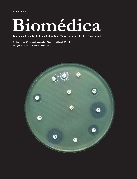Changes over time in the distribution of dominant clonal complexes of methicillin-resistant Staphylococcus aureus in Medellín, Colombia
Abstract
Introduction: Part of the success of methicillin-resistant Staphylococcus aureus (MRSA) as a pathogen responds to the rapid spread of pandemic lineages with diverse virulence and antimicrobial susceptibility profiles. In Colombia, several healthcare-associated MRSA (HA-MRSA) clones have been found, including the pediatric clone (CC5-ST5-SCCmecIV), the Brazilian clone (CC8-ST239-SCCmecIII), and the Chilean/Cordobés clone (CC5-ST5-SCCmecI). Moreover, the community-associated MRSA (CA-MRSA) clone USA300 has been reported as causing hospital-acquired infections.
Objective: To describe the changes over time in the distribution of MRSA clones from a university hospital in Medellín collected at two time points a decade apart.
Materials and methods: A total of 398 MRSA strains were analyzed. Of these, 67 strains were collected in 1994, while the remaining 331 strains were collected between 2008 and 2010. Species identification and methicillin resistance were confirmed by detection of nuc and mecA genes, respectively. Molecular characterization included spa typing, SCCmec typing, PFGE and MLST.
Results: Analysis of the MRSA strains collected in 1994 revealed that they belonged to a single clone, the CC5-SCCmecIV, whereas among the isolates from 2008-2010, two dominant clones were identified: CC8-SCCmecIVc, which included spa types t008 and t1610 and is closely related to the USA 300 clone, and CC5-SCCmecI (spa type t149), related to the Chilean clone. The ST5-SCCmecIV clone from 1994 was not detected.
Conclusions: This study identifies temporal dynamics in MRSA clone diversity, and highlights the importance of local surveillance and dissemination of results, especially in countries like Colombia where MRSA is prevalent and knowledge regarding its epidemiology is still insufficient.
Downloads
Some similar items:
- Constanza Pardo, Ricardo Cendales, Survival analysis of cervical cancer patients , Biomedica: Vol. 29 No. 3 (2009)
- Raúl Murillo, Ricardo Cendales, Carolina Wiesner, Marion Piñeros, Sandra Tovar, Effectiveness of cytology-based cervical cancer screening in the Colombian health system , Biomedica: Vol. 29 No. 3 (2009)
- Sandra Lorena Girón, Julio César Mateus, Fabián Méndez, Impact of an open waste disposal site on the occurrence of respiratory symptoms and on health care costs of children , Biomedica: Vol. 29 No. 3 (2009)
- José Joaquín Carvajal, Ligia Inés Moncada, Mauricio Humberto Rodríguez, Ligia del Pilar Pérez, Víctor Alberto Olano, Characterization of Aedes albopictus (Skuse, 1894) (Diptera:Culicidae) larval habitats near the Amazon River in Colombia , Biomedica: Vol. 29 No. 3 (2009)
- Andrés Páez, Gloria Rey, Carlos Agudelo, Alvaro Dulce, Edgar Parra, Hernando Díaz-Granados, Damaris Heredia, Luis Polo, Outbreak of urban rabies transmitted by dogs in Santa Marta, northern Colombia , Biomedica: Vol. 29 No. 3 (2009)
- Patricia Escobar, Katherine Paola Luna, Indira Paola Hernández, César Mauricio Rueda, María Magdalena Zorro, Simon L. Croft, In vitro susceptibility of Trypanosoma cruzi strains from Santander, Colombia, to hexadecylphosphocholine (miltefosine), nifurtimox and benznidazole , Biomedica: Vol. 29 No. 3 (2009)
- Gustavo Pradilla, Julio César Mantilla, Reynaldo Badillo, Human rabies encephalitis by a vampire bat bite in an urban area of Colombia , Biomedica: Vol. 29 No. 2 (2009)
- Mauricio Beltrán, María Cristina Navas, María Patricia Arbeláez, Jorge Donado, Sergio Jaramillo, Fernando De la Hoz, Cecilia Estrada, Lucía del Pilar Cortés, Amalia de Maldonado, Gloria Rey, Seroprevalence of hepatitis B virus and human immunodeficiency virus infection in a population of multiply-transfused patients in Colombia , Biomedica: Vol. 29 No. 2 (2009)
- Rosa Magdalena Uscátegui, Adriana M. Correa, Jaime Carmona-Fonseca, Changes in retinol, hemoglobin and ferritin concentrations in Colombian children with malaria , Biomedica: Vol. 29 No. 2 (2009)
- Claudia M.E. Romero-Vivas, Luis Eduardo Castro, Lila Visbal, Ana María Santos, Esther Díaz, Cutaneous myiasis by Cochliomyia hominivorax (Coquerel) (Díptera Calliphoridae) in Hospital Universidad del Norte, Soledad, Atlántico , Biomedica: Vol. 29 No. 1 (2009)
| Article metrics | |
|---|---|
| Abstract views | |
| Galley vies | |
| PDF Views | |
| HTML views | |
| Other views | |


























